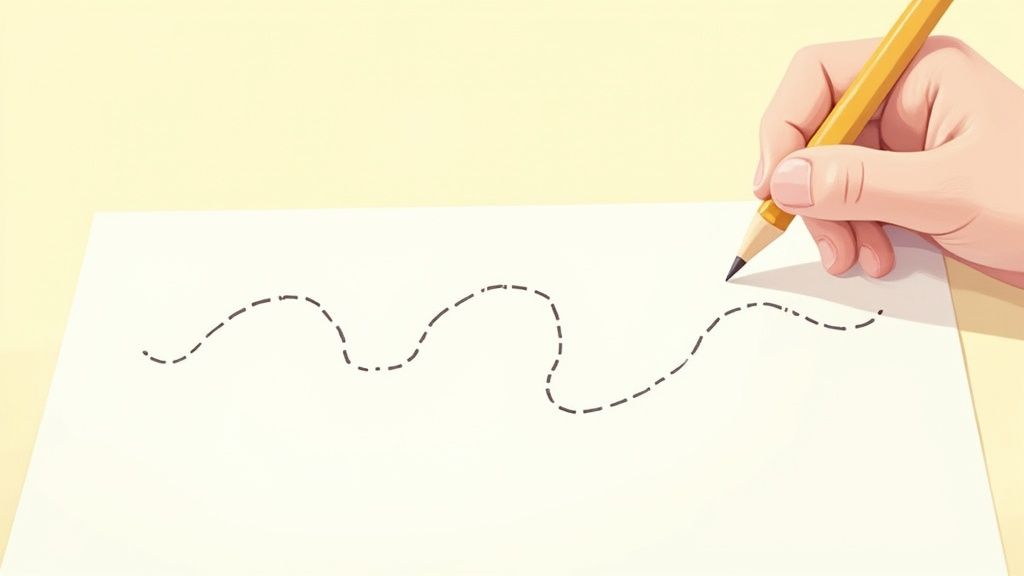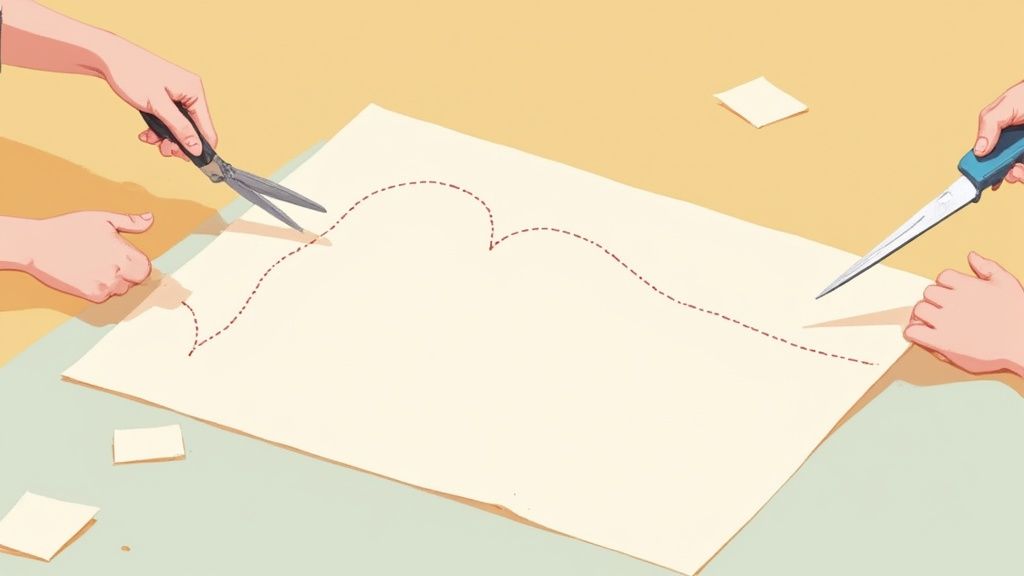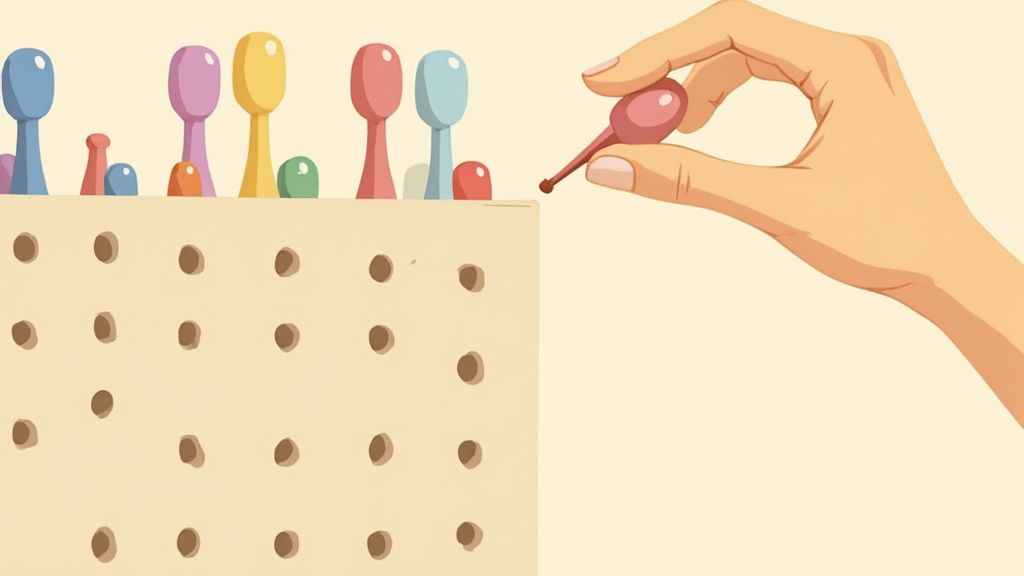7 Fun Visual Motor Integration Activities for 2025
July 30, 2025

Ever watched a child try to copy a shape, catch a ball, or cut along a dotted line? What you're seeing is visual motor integration in action. It’s the brain’s ability to process what the eyes see and then use that information to direct the hands and body to perform a task. This essential "eye-hand coordination" is more than just a developmental milestone; it's the foundation for everything from writing and typing to playing sports and tying shoelaces. Improving these skills doesn't have to feel like a chore. In fact, it can be incredibly fun.
This guide is packed with engaging and practical visual motor integration activities designed to strengthen this crucial connection. We'll move beyond generic advice and dive into specific, actionable ideas that you can implement right away. From creative cut-and-paste projects using personalized coloring pages to dynamic ball games and digital drawing exercises, each activity is broken down with clear steps and tips. Whether you're a parent, teacher, or therapist, you'll find fresh approaches to help build confidence and coordination. Let’s jump into some activities that transform skill-building into playtime.
1. Tracing and Pre-Writing Activities
Tracing and pre-writing exercises are the bedrock of visual-motor development. They directly train the brain to connect what the eyes see with the movements the hands make. Think of it as building the superhighway between visual perception and fine motor control, paving the way for everything from writing the alphabet to tying shoelaces. These foundational tasks help children understand how to form lines, curves, and shapes, which are the building blocks of letters and numbers.

This category of visual motor integration activities is crucial because it establishes the muscle memory and coordination necessary for academic success. Pioneers like Maria Montessori and Jan Olsen (founder of Handwriting Without Tears) built their educational methods on this very principle. They recognized that before a child can write, they must first master the movements required for writing.
How to Get Started
Getting started is simple, but the key is to make it engaging and progress logically. Don't jump straight to holding a pencil and tracing tiny letters.
- Go Big First: Start with large, whole-arm movements. Have your child trace giant shapes in the air with their finger, draw in a sand tray, or use finger paints on a large sheet of paper. This builds shoulder and arm strength, which is essential for stabilizing the hand for finer tasks.
- Multi-Sensory Magic: Engage more than just sight and touch. Use bumpy, textured paper, trace over sandpaper letters, or squish playdough into letter shapes. The more senses involved, the stronger the neural pathways become.
- Focus on Form: From the very beginning, gently guide your child toward a proper pencil grip and encourage them to sit with good posture. Making this a habit early on prevents the need to correct it later.
Pro-Tip: Use personalized coloring pages featuring your child's name or favorite characters. Tracing the outlines of a beloved superhero or the letters in their own name is far more motivating than a standard worksheet. This simple twist turns a therapeutic task into a fun, personal project.
By focusing on these pre-writing fundamentals, you give your child a powerful head start. You aren't just teaching them to trace; you are building the intricate coordination that supports a lifetime of learning.
2. Cut and Paste Projects
Cutting and pasting are dynamic activities that significantly boost visual motor skills. These projects demand that the brain and hands work in perfect sync; the eyes must track a line or shape, while the hands manipulate scissors to follow that path and then precisely place the cut-out pieces. It's an excellent two-for-one exercise that develops bilateral coordination (using both hands together), hand strength, and spatial awareness.

This type of visual motor integration activity is a staple in early childhood education and pediatric therapy for a reason. Art therapists and occupational therapists use collage-making and craft projects to help children refine their motor control in a fun, rewarding way. The final creation, whether it's a paper chain or a complex mosaic, provides a tangible sense of accomplishment that motivates further practice.
How to Get Started
To set your child up for success, start simple and gradually increase the complexity. The goal is to build confidence, not create frustration.
- Scissor Selection is Key: Begin with spring-loaded or loop scissors, which automatically pop back open after a cut. This allows the child to focus solely on the closing motion without having to coordinate opening the scissors as well.
- Start with Snips: Before cutting lines, practice just snipping the edges of a piece of paper or a strip of construction paper. This builds the fundamental open-and-close motion. Progress to cutting along thick, straight, high-contrast lines before moving on to curves and complex shapes.
- Proper Positioning: Teach the "thumbs up" rule for holding both the scissors and the paper. The thumb should be in the top loop of the scissors and pointing toward the ceiling. The helper hand holds the paper, also with the thumb on top, to guide it as it's being cut.
Pro-Tip: Turn worksheets into a hands-on activity. Instead of having a child circle the answers on a math or phonics page, have them cut out the correct answers from the bottom of the sheet and glue them into place. This reinforces academic concepts while simultaneously building critical visual-motor skills.
By incorporating cutting and pasting, you transform simple paper crafts into powerful developmental tools. You aren't just making a mess with glue; you're building the precision and coordination needed for everything from buttoning a shirt to writing neatly.
3. Pegboard and Bead Threading
Pegboard and bead threading activities are classic, powerful tools for honing visual-motor skills. These tasks require a child to see a target (a hole or a bead's opening), plan a motor action, and execute a precise hand movement to place a peg or guide a string. This direct translation of a visual plan into a physical action is the very essence of visual-motor integration, strengthening hand-eye coordination and pincer grasp.

This category of visual motor integration activities is a staple in both educational and therapeutic settings for good reason. From the iconic Lite-Brite toys popularized by Hasbro to the methodical bead threading exercises found in Montessori classrooms, these activities build crucial dexterity. Pediatric occupational therapists frequently use them to develop the refined control necessary for tasks like buttoning a shirt or using utensils.
How to Get Started
The beauty of these activities lies in their scalability. You can easily adjust the difficulty to match and challenge a child's current skill level, making progress feel natural and rewarding.
- Start Large, Go Small: Begin with chunky pegs and large beads with wide holes. This allows the child to experience success while building foundational skills. As they gain confidence and control, gradually introduce smaller pegs and beads with finer laces.
- Use Visual Patterns: Provide simple pattern cards for the child to replicate on their pegboard or with their beads. This adds a cognitive layer, forcing them to visually scan the pattern, hold it in their working memory, and then reproduce it.
- Encourage Bilateral Coordination: Promote the use of two hands. One hand acts as the "helper" to stabilize the pegboard or hold the string taut, while the dominant hand performs the precise action of placing the peg or threading the bead. This two-handed cooperation is a vital life skill.
Pro-Tip: Make the activity functional and meaningful. Instead of just threading random beads, have your child create a patterned bracelet to wear or give as a gift. With pegboards, challenge them to "draw" a picture of a house, a sun, or the first letter of their name. Giving the task a tangible purpose boosts motivation significantly.
By incorporating pegboards and beads, you are providing a hands-on lab for developing intricate hand-eye coordination. These engaging exercises are fundamental for building the fine motor skills development activities that support everything from handwriting to independent self-care.
4. Block Building and Construction Activities
Building with blocks is far more than just play; it's a three-dimensional masterclass in visual-motor integration. This hands-on activity requires children to mentally visualize a structure, understand spatial relationships, and then translate that mental blueprint into precise physical action. They must see where a block needs to go, figure out how to orient it, and use coordinated hand movements to place it correctly.

These types of visual motor integration activities are fundamental to early childhood education, championed by figures like Friedrich Froebel, the inventor of kindergarten, and embraced by modern STEM programs using LEGOs and K'NEX. They understood that constructing objects in the real world builds the neural pathways necessary for understanding abstract concepts like geometry and physics later on. It’s a tangible way to practice planning, problem-solving, and hand-eye coordination.
How to Get Started
To make block building effective and fun, it's helpful to provide a bit of structure and gradually increase the complexity of the tasks.
- Start with Visual Models: Begin by providing simple instruction cards or a pre-built model for the child to copy. This isolates the skill of translating a 2D or 3D image into a physical creation, which is the core of visual-motor work.
- Encourage Planning: Before they start building, have them talk about their plan. Ask questions like, "What piece will you start with for the base?" or "How will you make the tower stable?" This integrates cognitive planning with the motor task.
- Vary the Materials: Move beyond basic wooden blocks. Use interlocking blocks like LEGOs, magnetic tiles, or even construction sets with nuts and bolts. Each type of material offers a different level of fine motor challenge, from simple stacking to complex assembly.
Pro-Tip: Turn building into a storytelling activity. Challenge your child to build a castle for a knight, a garage for their favorite toy car, or a bridge to cross a "river" of blue paper. Creating a narrative context makes the task more engaging and gives their construction a clear purpose, boosting motivation and creative thinking.
By incorporating block building, you’re not just keeping your child busy. You are helping them build a strong foundation in spatial awareness, fine motor precision, and the critical ability to bring a visual idea to life.
5. Mazes and Dot-to-Dot Activities
Mazes and dot-to-dot puzzles are classic childhood pastimes for a reason. They are stealthy and effective tools for developing sophisticated visual-motor skills. These activities require a child to visually scan a path or a sequence of numbers, plan their hand’s route, and then execute that plan with controlled, continuous movements. This is a direct workout for the brain's ability to coordinate visual tracking with precise motor output.
These paper-based visual motor integration activities are fantastic because they demand constant feedback between the eyes and the hand. The eyes must look ahead to anticipate turns and find the next number, while the hand must adjust its speed and direction accordingly. Publishers like Scholastic and iconic magazines such as Highlights for Children have long recognized the power of these puzzles, making them a staple in both educational and recreational settings for decades.
How to Get Started
The beauty of mazes and dot-to-dots is their scalability. You can easily adjust the difficulty to match and gently challenge a child’s current skill level.
- Start Simple and Wide: Begin with mazes that have very wide pathways and no dead ends. For dot-to-dots, start with simple pictures using fewer than 20 large, clearly-marked dots. This builds confidence and masters the basic concept of following a line or sequence.
- Encourage Planning: Before they even put pencil to paper, encourage your child to trace the path of the maze or the sequence of numbers with their finger. This "preview" helps them practice the motor planning component without the pressure of making a permanent mark.
- Add a Splash of Color: Don't just stick to a gray pencil. Using colored pencils, markers, or even a line of glitter glue can make the activity far more engaging. Let them choose the color to make the path, turning a simple task into a creative expression. You can learn more about how these games boost key cognitive skills in our guide to activities for visual perception.
Pro-Tip: Create your own custom dot-to-dot puzzles. You can lightly draw a simple shape your child loves (like a star, a car, or their initial) and place numbered dots along the outline. Revealing a familiar or favorite shape provides a powerful and motivating reward for completing the sequence correctly.
By turning these puzzles into playful challenges, you are helping your child develop crucial skills like visual scanning, motor planning, and sustained attention, all disguised as fun.
6. Ball Activities and Target Games
Ball activities and target games take visual-motor skills into the dynamic, three-dimensional world. These activities force the brain to rapidly process distance, speed, and trajectory, then command the body to react with precise timing. It's about more than just playing catch; it's about training the eyes and hands to work together to intercept or direct a moving object in space, a fundamental skill for sports, playground games, and even safely navigating a busy room.
This type of visual motor integration activity is a cornerstone of pediatric occupational and physical therapy. Experts in vision therapy and adapted physical education have long used ball-based exercises to improve everything from reaction time to depth perception. They understand that successfully catching, throwing, or hitting a ball requires a sophisticated, high-speed connection between the visual system and motor execution. For those looking to apply ball activities in a structured sports context, exploring specific soccer drills can provide further ideas.
How to Get Started
The key is to set up a child for success by starting simple and gradually increasing the challenge. The goal is to build confidence, not create frustration.
- Start Large and Slow: Begin with larger, softer, and slower-moving objects like balloons or beach balls. These give the child more time to visually track the object and plan their movement, making it easier to succeed. Catching a large ball with two hands is the first step.
- Stationary Targets First: Before trying to hit a moving target, practice with stationary ones. Set up empty plastic bottles for bowling, a laundry basket for tossing beanbags into, or large cardboard cutouts to aim at. This isolates the throwing/aiming skill without the added complexity of a moving object.
- Add Color and Sound: Use brightly colored balls that stand out against the background to make visual tracking easier. A ball with a bell inside can add an auditory cue, engaging another sense to help locate it in space.
Pro-Tip: Create your own target games using personalized elements. Print out large coloring pages of villains or "monsters" and tape them to cardboard boxes. The child's mission is to "defeat" them by hitting them with a soft ball. This turns a therapeutic exercise into an exciting and imaginative game.
By incorporating ball and target games, you move visual-motor practice from the tabletop to a full-body experience. You're not just improving coordination; you are building a foundation for physical confidence and active play.
7. Digital Drawing and Tablet Activities
Leveraging technology can be a powerful and highly motivating way to enhance visual-motor skills. Digital drawing and tablet activities combine the foundational principles of hand-eye coordination with the engaging, interactive nature of modern devices. Using a stylus on a screen mimics the pen-on-paper experience but offers immediate feedback, vibrant colors, and endless "do-over" potential, which reduces frustration for many children.
This modern category of visual motor integration activities has been championed by progressive educators and occupational therapists. They recognize that digital tools are not just for entertainment; they are a legitimate medium for skill development. Apps like 'Writing Wizard' and the use of SMART Boards in classrooms prove that technology can provide a structured, gamified approach to mastering the connection between what the eyes see and what the hands do. The digital transformation in education continues to offer new ways to support learning.
How to Get Started
Integrating digital tools effectively requires a thoughtful approach that balances screen time with traditional methods. The goal is to use technology as a supportive tool, not a replacement for hands-on experience.
- Choose Purpose-Built Apps: Not all drawing apps are created equal. Look for applications specifically designed for skill development, which often include guided tracing, letter formation prompts, and tasks that increase in difficulty.
- Prioritize a Proper Stylus: While finger-tracing is a good start, using a stylus is crucial for developing a functional pencil grasp. Choose a stylus that is appropriately sized for your child's hand to encourage a proper three-finger grip. For instance, exploring various digital art software can open up new avenues for engaging tablet-based activities.
- Mind the Setup: Ensure your child is sitting with good posture, feet on the floor, and the tablet positioned at a comfortable angle. This prevents poor habits and physical strain, mirroring the ideal setup for traditional writing.
Pro-Tip: Use the tablet to 'trace' over real-world images. Take a picture of your child's favorite toy, their name written on a piece of paper, or a simple shape, and import it into a drawing app. Have them trace the outlines on the screen. This personalizes the activity and directly connects the digital world to their physical environment.
Visual Motor Integration Activities Comparison
| Activity | Implementation Complexity 🔄 | Resource Requirements ⚡ | Expected Outcomes 📊 | Ideal Use Cases 💡 | Key Advantages ⭐ |
|---|---|---|---|---|---|
| Tracing and Pre-Writing Activities | Low to moderate 🔄 | Minimal materials ⚡ | Builds fine motor control and letter formation 📊 | Early childhood handwriting foundations 💡 | Easy to implement, measurable progress ⭐ |
| Cut and Paste Projects | Moderate 🔄 | Child-safe scissors, paper, glue ⚡ | Develops scissor skills, spatial planning 📊 | Art integration, developing bilateral coordination 💡 | Enhances creativity, integrates academic subjects ⭐ |
| Pegboard and Bead Threading | Moderate 🔄 | Pegboards, beads, strings ⚡ | Strengthens pincer grasp, pattern recognition 📊 | Fine motor development, pattern sequencing 💡 | Immediate visual feedback, academic learning support ⭐ |
| Block Building and Construction | Moderate to high 🔄 | Blocks, LEGOs, construction sets ⚡ | Enhances spatial reasoning, problem-solving skills 📊 | STEM learning, imaginative play, group activities 💡 | Builds 3D visualization, promotes creativity ⭐ |
| Mazes and Dot-to-Dot Activities | Low 🔄 | Paper, pencils ⚡ | Improves visual tracking and sustained attention 📊 | Visual perception training, academic reinforcement 💡 | Easy access, incorporates educational content ⭐ |
| Ball Activities and Target Games | Moderate 🔄 | Balls, targets, open space ⚡ | Develops hand-eye coordination, timing, spatial skills 📊 | Physical education, therapy, group play 💡 | Highly engaging, builds confidence and fitness ⭐ |
| Digital Drawing and Tablet Activities | Moderate to high 🔄 | Tablets, styluses, software ⚡ | Enhances digital literacy and fine motor precision 📊 | Tech-integrated learning, special education 💡 | Immediate feedback, customizable, engaging ⭐ |
Putting It All Together: The Power of Play in Visual Motor Integration
We’ve explored a fantastic range of visual motor integration activities, from the foundational focus of tracing and pre-writing lines to the dynamic, full-body coordination required for ball games. We've seen how simple materials like blocks, beads, and even a pair of safety scissors can become powerful tools for development. The common thread weaving through all these methods is the crucial partnership between what the eyes see and what the hands do. This isn't just about coloring inside the lines; it's about building the neurological superhighways that support everything from writing a name to tying a shoe.
The journey to strengthening these skills doesn’t require expensive equipment or complicated setups. The most effective strategies are often the ones that feel less like work and more like play. Whether it's the satisfaction of connecting the dots in a complex maze, the creative expression of a cut-and-paste collage, or the digital precision of a tablet drawing app, engagement is the secret ingredient.
Key Takeaways for Building Stronger Skills
Let's recap the core principles that make these activities so effective:
- Start Simple, Build Complexity: Begin with basic movements like tracing straight lines before moving on to intricate mazes or detailed construction projects. This gradual progression builds confidence and prevents frustration.
- Variety is Vital: Don't stick to just one type of activity. Mixing it up by moving from tabletop tasks like beading to active games like catching a ball keeps things exciting and engages different muscle groups and cognitive processes.
- Personalization is a Superpower: The activities that resonate most are those tied to a child's or individual's interests. A dinosaur-themed dot-to-dot or a personalized coloring page of a favorite pet will always be more engaging than a generic worksheet.
- Focus on the Process, Not Perfection: The goal of these visual motor integration activities is skill development, not a flawless final product. Celebrate the effort, the attempt, and the small improvements along the way.
Your Actionable Next Steps
So, where do you go from here? The most important step is to simply start. Don't feel pressured to implement every idea at once. Pick one or two activities from this list that seem like the best fit for your child, student, or even yourself.
Observe what sparks joy and interest. If block building is a hit, lean into it with more complex designs. If mazes are the winner, find progressively harder ones. The key is to transform these developmental tasks into cherished moments of connection, creativity, and fun. By consistently incorporating these playful exercises into your routine, you are providing the essential practice needed to make the connection between sight and action smooth, automatic, and efficient for a lifetime of learning and achievement.
Ready to make these activities even more engaging? Use ColorPageAI to instantly generate custom coloring pages, dot-to-dots, and mazes based on any theme or interest you can imagine. Turn a favorite movie character or a beloved family pet into a fun and effective tool for building skills. Visit ColorPageAI to bring your unique ideas to life and supercharge your visual motor integration practice
Ready to start coloring?
Join ColorPage.ai today and get 5 free credits to create your own custom coloring pages!
Start creating